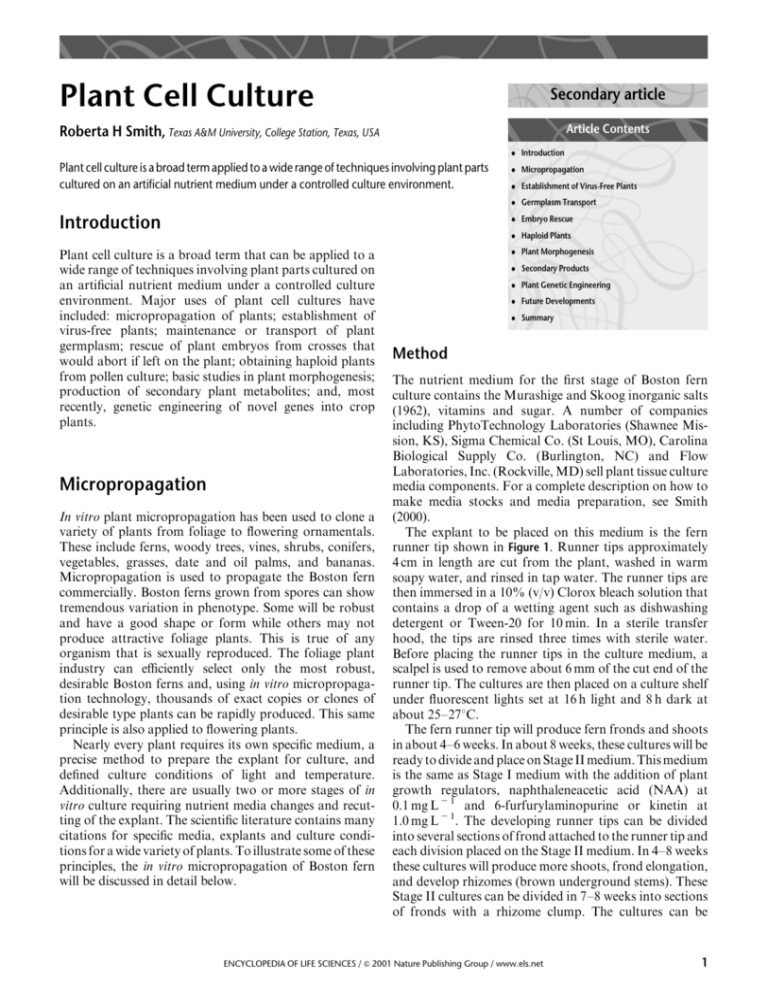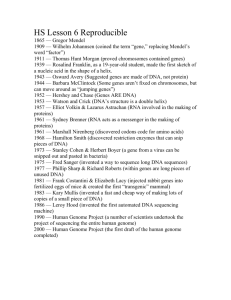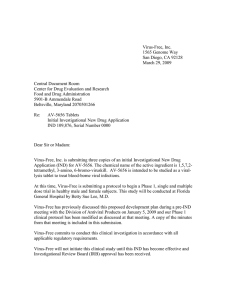Plant Cell Culture
advertisement

Plant Cell Culture Secondary article Article Contents Roberta H Smith, Texas A&M University, College Station, Texas, USA . Introduction Plant cell culture is a broad term applied to a wide range of techniques involving plant parts cultured on an artificial nutrient medium under a controlled culture environment. . Micropropagation . Establishment of Virus-Free Plants . Germplasm Transport Introduction . Embryo Rescue Plant cell culture is a broad term that can be applied to a wide range of techniques involving plant parts cultured on an artificial nutrient medium under a controlled culture environment. Major uses of plant cell cultures have included: micropropagation of plants; establishment of virus-free plants; maintenance or transport of plant germplasm; rescue of plant embryos from crosses that would abort if left on the plant; obtaining haploid plants from pollen culture; basic studies in plant morphogenesis; production of secondary plant metabolites; and, most recently, genetic engineering of novel genes into crop plants. . Plant Morphogenesis . Haploid Plants Micropropagation In vitro plant micropropagation has been used to clone a variety of plants from foliage to flowering ornamentals. These include ferns, woody trees, vines, shrubs, conifers, vegetables, grasses, date and oil palms, and bananas. Micropropagation is used to propagate the Boston fern commercially. Boston ferns grown from spores can show tremendous variation in phenotype. Some will be robust and have a good shape or form while others may not produce attractive foliage plants. This is true of any organism that is sexually reproduced. The foliage plant industry can efficiently select only the most robust, desirable Boston ferns and, using in vitro micropropagation technology, thousands of exact copies or clones of desirable type plants can be rapidly produced. This same principle is also applied to flowering plants. Nearly every plant requires its own specific medium, a precise method to prepare the explant for culture, and defined culture conditions of light and temperature. Additionally, there are usually two or more stages of in vitro culture requiring nutrient media changes and recutting of the explant. The scientific literature contains many citations for specific media, explants and culture conditions for a wide variety of plants. To illustrate some of these principles, the in vitro micropropagation of Boston fern will be discussed in detail below. . Secondary Products . Plant Genetic Engineering . Future Developments . Summary Method The nutrient medium for the first stage of Boston fern culture contains the Murashige and Skoog inorganic salts (1962), vitamins and sugar. A number of companies including PhytoTechnology Laboratories (Shawnee Mission, KS), Sigma Chemical Co. (St Louis, MO), Carolina Biological Supply Co. (Burlington, NC) and Flow Laboratories, Inc. (Rockville, MD) sell plant tissue culture media components. For a complete description on how to make media stocks and media preparation, see Smith (2000). The explant to be placed on this medium is the fern runner tip shown in Figure 1. Runner tips approximately 4 cm in length are cut from the plant, washed in warm soapy water, and rinsed in tap water. The runner tips are then immersed in a 10% (v/v) Clorox bleach solution that contains a drop of a wetting agent such as dishwashing detergent or Tween-20 for 10 min. In a sterile transfer hood, the tips are rinsed three times with sterile water. Before placing the runner tips in the culture medium, a scalpel is used to remove about 6 mm of the cut end of the runner tip. The cultures are then placed on a culture shelf under fluorescent lights set at 16 h light and 8 h dark at about 25–278C. The fern runner tip will produce fern fronds and shoots in about 4–6 weeks. In about 8 weeks, these cultures will be ready to divide and place on Stage II medium. This medium is the same as Stage I medium with the addition of plant growth regulators, naphthaleneacetic acid (NAA) at 0.1 mg L 2 1 and 6-furfurylaminopurine or kinetin at 1.0 mg L 2 1. The developing runner tips can be divided into several sections of frond attached to the runner tip and each division placed on the Stage II medium. In 4–8 weeks these cultures will produce more shoots, frond elongation, and develop rhizomes (brown underground stems). These Stage II cultures can be divided in 7–8 weeks into sections of fronds with a rhizome clump. The cultures can be ENCYCLOPEDIA OF LIFE SCIENCES / & 2001 Nature Publishing Group / www.els.net 1 Plant Cell Culture routinely applied to potatoes, strawberries, citrus, nandina, carnation, orchids and hydrangea, and to many other plants to reestablish virus-free plant material. Outline of method The shoot apex or meristem tissue of rapidly growing plants usually does not contain the virus; therefore, using a microscope the small shoot apical dome with one or two primordial leaves can be excised and placed on sterile culture for growth into a virus-free plant. The resulting plant must be indexed or verified that it is free of the virus in question before it can be claimed that the plant is free of that virus. Shoot meristem culture does not always result in virus-free plants. Germplasm Transport Figure 1 Boston fern runner tip approximately 4 cm long. After surface disinfestation, the Clorox burned end is cut off and the tip is placed in culture. recultured onto fresh Stage II medium for further proliferation and division or the clumps can be transferred to soil. However, to ensure strong plants for transfer to soil, these clumps can be transferred to a Stage III medium for plant development. Stage III medium is the same as Stage I medium but it is agar solidified (6 g L 2 1 agar). Baby food jars or Mason jars make excellent containers. Once the small plants have been placed in Stage III medium, rooting and plant development will occur in 2–3 weeks. These plants can then be transferred to a potting mix, being careful to wash off the nutrient agar completely. The young plants should be kept under conditions of high humidity initially while they harden off. In about 2 weeks the humidity can be gradually reduced. A concern with the transportation of whole plants across international borders is that the plants or soil adhering to the root system will contain insects, bacteria or fungi that will cause disease problems at the new location of the plant. An alternative to transporting whole plants is the use of plant cell cultures. These can be transported relatively easily and can bypass lengthy quarantine procedures for moving plant material. Additionally, it is sometimes easier to collect rare plant material or plants that are large and place tissue in culture at the collection site to transport it back to the laboratory. Outline of method Plant material in plant cell culture that is visibly free of fungal and bacterial growth after about 5 days in culture can generally be considered to be free of microbes and insect contamination, but not of viruses. Once in the laboratory at the new location, the material can be propagated in culture and/or moved into soil. Establishment of Virus-Free Plants Embryo Rescue Virus infection can result in lack of plant vigour, loss in yields, necrosis of leaf tissue, undesirable streaks in flower petals, and twisted or contorted leaves. Many important crops, trees, shrubs and ornamental plants are infected with one or more viruses. Heat treatments are sometimes effective in ridding a plant of a virus, but chemical treatments are not very effective. A more successful method is one using cell culture techniques. Virus-free tissues in the shoot meristem of a plant can be cultured in vitro to develop into virus-free plants. This technology is Plant breeding and development programmes make use of plant crosses, or hybrids. When crosses are wide it may be that various incompatibility problems will cause the developing embryo to begin to die (abort) if it is left on the plant. Using plant cell culture techniques the embryo can be rescued from the plant and cultured on a nutrient medium in vitro. Often this hybrid embryo will continue its development in vitro into a plant. Many hybrids grown in this way have been very useful in plant breeding improvement programmes. 2 ENCYCLOPEDIA OF LIFE SCIENCES / & 2001 Nature Publishing Group / www.els.net Plant Cell Culture Haploid Plants Many breeding improvement programmes require homozygous diploid plant material. To develop this plant material normally requires many years of backcrossing. However, using cell culture, haploid and homozygous diploid plants can be derived in only a few months. Haploid plant material is also useful in mutation studies. Anther culture is used in plant breeding improvement programmes, particularly in cereal breeding programmes, to obtain haploid plants. In many cases where valuable metabolites are harvested from plants and the plants are not plentiful, cultivation is difficult, or political situations make harvesting the plant material unreliable, it would be desirable to develop plant cell cultures capable of actively producing the desired compound. This could lead to controlled year-round production of the compound. A recent example is the interest in developing yew tree cell cultures to produce the potent anticancer drug, taxol. Plant Genetic Engineering Outline of method This technique involves culturing an immature anther in vitro, or sometimes even isolating the immature pollen from within the anther. The immature pollen may divide in such a way that it will produce callus, or it may produce embryos directly that develop into haploid plants. The callus will often form embryos or shoots that can be established as plants. Plants obtained from anther or pollen culture will generally be haploid; however, sometimes they will have spontaneously doubled and be homozygous diploid. The plants may also originate from the anther wall or maternal tissue of the plant, in which case they will be diploid, but these diploids are heterozygous. Plant Morphogenesis Since their first development plant cell culture techniques have been used extensively to better our understanding of plant morphogenesis – the study of inception and development of plant form from cell to plant structure. Early studies in plant cell culture involved identifying the nutrients and plant growth regulators that would support plant cell growth into callus and regeneration of whole plants. The study of plant morphogenesis laid the foundation for all aspects of plant cell culture as we know them today. Current studies focus on defining the medium and growth conditions to regenerate whole plants from callus or cell cultures. Secondary Products Many valuable products are routinely harvested from plants. It has been found that some cell cultures from these plants can produce the same products as the original plants, or even unique products that have economic value. Secondary products or metabolites from plant cell cultures have had widespread interest for production of pharmaceuticals, valuable metabolites, flavouring compounds and natural products. Plant genetic engineering has been the most exciting and rapidly moving area in plant cell culture. A major goal has been to insert foreign DNA into plant cells and regenerate whole plants that have the foreign DNA integrated into the plant genomic DNA. This new DNA will then be expressed and inherited by the progeny from that plant. Genetically altered canola, cotton, corn and soya beans are now being grown by farmers. These crop plants contain foreign DNA or genes for insect or herbicide resistance or, in the case of canola, genes to alter the oil composition. This has created a revolution in farming. Crop resistance to insects and herbicides can cut the use of pesticides and herbicides that can pollute the environment and add to the cost of crop production. Alteration in the composition of oils in oil crop plants can have health benefits and give added economic value to the farmer. Crop plants like corn that have genes to produce unique proteins can be converted to biological manufacturing plants. Methods Three different major techniques are used to insert foreign DNA into plant cells. The first involves using a common soil bacterium, Agrobacterium tumefaciens, which infects wounded plant cells and transfers a piece of its DNA (DNA contains genes that determine characteristics of a cell), TDNA, into the plant cell. This results in the crown gall disease, a tumour outgrowth at the injury site due to plant cell proliferation induced by plant hormones on the TDNA. Molecular biologists can remove these tumourinducing genes and replace them with agriculturally important genes, such as genes to make the plant resistant to insects, herbicides, or any other desirable gene. When the genetically engineered Agrobacterium infects the cell, the foreign DNA (genes) can be inserted into the plant’s DNA. These cells can divide in culture and reform transgenic plants (plants containing foreign DNA or genes). Another method of inserting foreign genes into a plant cell is to use enzymes to digest away the plant cell wall, resulting in a plant protoplast, a plant cell without its rigid cell wall. Protoplasts can take up foreign DNA (genes) by ENCYCLOPEDIA OF LIFE SCIENCES / & 2001 Nature Publishing Group / www.els.net 3 Plant Cell Culture either passing an electrical current through the solution containing the protoplasts and the foreign genes or by chemical means. The end result is a protoplast containing the new gene. Protoplasts can be cultured to reform a cell wall and regenerate back into plants in cell culture. The last major method to put foreign genes into plants is microprojectile bombardment or biolistics. This method involves coating the DNA or genes onto small gold or tungsten microparticles and shooting them into cultured plant cells. If a particle hits an individual cell, it can deliver the DNA into the plant cell. The foreign gene can be incorporated and the cell can give rise to a transgenic plant. Future Developments Major concerns of commercial plant micropropagation include microbial contamination and cost reduction. New types of containers and culture systems are being developed and tested to reduce microbial contamination. The hand labour involved in cutting and separating the plant material is one of the most expensive components of cell culture. To overcome this constraint, robotic or automated systems are actively being developed and tested and for some systems appear to be feasible. Perhaps the most exciting area of plant cell culture is that of genetically modifying plants and the potential that it promises. There is intense activity in both the public and private sectors to identify useful genes for crop improvement and value-added crops. Possibilities include cotton fibre that has improved traits for textile manipulation, vaccines delivered in plants with edible fruit or vegetables, healthier oil composition from our oilseed crops, and oil more suitable for manufacturing purposes. 4 Summary Commercial micropropagation of many different types of plants is now a standard method in mass cloning of plants for diverse uses. Nearly all strawberries and potatoes have gone though cell culture to rid them of their viruses and improve yields. Most major universities and pharmaceutical, agriculture seed and chemical companies are involved in using cell culture for product or crop improvement. The future use of plant cell culture techniques will continue to be an important component of plant-based scientific research. References Murashige T and Skoog F (1962) A revised medium for rapid growth and bioassays with tobacco tissue cultures. Physiologia Plantarum 15: 473– 497. Smith RH (2000) Plant Tissue Culture Techniques and Experiments, 2nd edn. San Diego, CA: Academic Press. Further Reading Burr RW (1976) Mass propagation of ferns through tissue culture. In Vitro 12: 209–269. Cooke RC (1977) The use of an agar substitute in the initial growth of Boston ferns in vitro. HortScience 12: 339. Kyte L and Kleyn J (1996) Plants from Test Tubes: An Introduction to Micropropagation, 3rd edn. Portland, OR: Timber Press. Oki L (1981) The modification of research procedures for commercial propagation of Boston ferns. Environmental and Experimental Botany 21: 397–413. Pedhya MA and Mehta AR (1982) Propagation of fern (Nephrolepsis) through tissue culture. Plant Cell Reports 1: 261–263. Roberts DJ (1965) Modern propagation of ferns. Proceedings of the International Plant Propagation Society 15: 317–321. ENCYCLOPEDIA OF LIFE SCIENCES / & 2001 Nature Publishing Group / www.els.net








